Khemi
Harmless

Posts: 13
Registered: 20-9-2016
Member Is Offline
Mood: Hex n’ sex ftw
|
|
Hydroxylamine via HCL, Nitromethane, and H2O?
Can you arrive at (H3NO) Hydroxylamine hydrochloride by refluxing
(6mol)
648g HCL
450g H2O
366g Nitromethane
and if so, how long should the reflux take at 100c? How much distillate should be removed before crystallization will take place?
What is the anticipated yield of H3NO.hcl?
I truly appreciate the help/advice.
|
|
|
Texium
|
Thread Moved
20-9-2016 at 17:25 |
madcedar
Hazard to Others
  
Posts: 116
Registered: 10-9-2009
Member Is Offline
Mood: No Mood
|
|
Sure, I didn't check your ratios but Axo did it here (with pictures):
https://www.sciencemadness.org/whisper/viewthread.php?tid=58...
|
|
|
nitro-genes
International Hazard
    
Posts: 1048
Registered: 5-4-2005
Member Is Offline
|
|
Attachment: Action of mineral acids on primary nitroparafins.pdf (433kB)
This file has been downloaded 769 times
|
|
|
zed
International Hazard
    
Posts: 2283
Registered: 6-9-2008
Location: Great State of Jefferson, City of Portland
Member Is Offline
Mood: Semi-repentant Sith Lord
|
|
Ahhh. Something I hadn't suspected.
Nitromethane seems to produce Hydroxylamine PLUS Carbon Monoxide under these conditions. Gotta do something about that CO gas.
Perhaps this experiment is best performed, as an outdoor experiment.
|
|
|
nitro-genes
International Hazard
    
Posts: 1048
Registered: 5-4-2005
Member Is Offline
|
|
IIRC, only using highly concentrated sulfuric (>85%) carbon moonoxide is formed in large quantities, it's still best to perform this reaction
outside though. Not only due to any potential CO formed, but a layer (good stirring) of nitromethane saturated with HCl at >100 deg C. may also be
potentially explosive (although I couldn't find any examples were this was the case). The reaction with concentrated sulfuric is more dangerous, as
this produces some exotherm upon mixing/heating, and heating should be performed cautiously in the beginning. Also not sure if even very concentrated
HCl would produce any CO at all, as Axt's pressure bottle would have exploded if this was the case.
[Edited on 22-9-2016 by nitro-genes]
|
|
|
Tsjerk
International Hazard
    
Posts: 3032
Registered: 20-4-2005
Location: Netherlands
Member Is Offline
Mood: Mood
|
|
I repeated Axo's experiment a long time ago and I can tell that the reaction works. I do advice though to recrystallize the product a couple of times
as it seems that HCl ''sticks'' to the crystals.
|
|
|
nitro-genes
International Hazard
    
Posts: 1048
Registered: 5-4-2005
Member Is Offline
|
|
Both sulfuric drain cleaner and hardware store HCl can be contaminated with substantial amounts of transition metals, especially iron. Copper and
copper salts ares known to catalyse decomposition of hydroxylamine, not sure if this is the same for Fe3+ or still applies under very acidic
conditions, though maybe something to keep in mind?
|
|
|
Cryolite.
Hazard to Others
  
Posts: 269
Registered: 28-6-2016
Location: CA
Member Is Offline
Mood: No Mood
|
|
I just looked into it. ~0.2% of either ferrous or ferric iron contamination induces extremely violent (boiling) decomposition of 50% hydroxylamine in
water. See the attached paper.
However, the authors of that study performed their tests under neutral conditions. The presence of acid stabilizes hydroxylamine as hydroxylammonium,
much like acid stabilizes hydrazine as hydrazinium.
In fact, this https://infoscience.epfl.ch/record/176224/files/Billeter%20e... says that under acidic conditions, ionic iron doesn't do much of anything to
decompose hydroxylamine.
Thus, as long as you keep the solution acidic and crystallize the hydroxylamine salt out of solution, I wouldn't worry about iron contamination too
much.
Attachment: je030121p.pdf (132kB)
This file has been downloaded 562 times
[Edited on 22-9-2016 by Cryolite.]
|
|
|
nitro-genes
International Hazard
    
Posts: 1048
Registered: 5-4-2005
Member Is Offline
|
|
Thanks for looking that up, wouldn't have guessed 10 ppm ionic iron would have such dramatic effects. Better recrystallize the acid hydroxylamine when
planning to use the freebased hydroxylamine in a synthesis. 
|
|
|
Khemi
Harmless

Posts: 13
Registered: 20-9-2016
Member Is Offline
Mood: Hex n’ sex ftw
|
|
Thanks for the input!
If performed I would use a flask, fitted with a condenser, with a pressurized equalized additional funnel with a male outlet on top to direct any gas
that is evolved, outside.
I do not like the idea of making this in a pressurized vessel. I do like the idea of making it in the manner I laid out, even if the yield is slightly
less.
Can someone confirm if my ratios (in my original post) are on point if I intend on carrying out this synthesis in this manner?
648g of 31.45%
450g H2O
366g Nitromethane
Im guessing 175g of Hydroxylamine.HCl would be about the yield, give or take a few grams.
Do my ratios look ok?
|
|
|
greenlight
National Hazard
   
Posts: 737
Registered: 3-11-2014
Member Is Offline
Mood: Energetic
|
|
Thought I would add to this instead of making a 200th hydroxylamine thread.
The acid-catalyzed hydrolysis of nitromethane with hydrochloric acid was attempted without sealing of mixture in a vessel or pressure application.
228 grams of 32% hardware store hydrochloric acid was mixed with 122 grams of remote control car fuel grade nitromethane in a round bottom flask. A
condenser was attached with a loose smaller size plastic stopper placed on top and the flask placed in a 100*C oil bath. The apparatus was set up
outside.
After 8 hours of heating, the had formed a dark top layer. Reflux was continued for 42 hours peridically with the apparatus being shut off at night
time. Slowly, the nitromethane layer became smaller and the aqueous layer darker yellow until a homogenous mixture resulted. Small amounts of white
fuming was noticed during this time
The mixture was transferrred to a beaker and heating continued on a hotplate until 1/3 of the solvent was removed. At this time heating was turned
off and and the dark yellow-orange liquid left to cool. After room temperature was reached, slight agitation of the beakers contents resulted in a
crash precipitation of a large amount of white hydroxylamine hydrochloride flakes. The crop of crystals was filtered and dried while the solvent was
returned to heat and reduced ny half volume. A second crop of hydroxylamine was recovered and after drying, final yield was 51.53g.
Theoretical yield would be 138.80g so this corresponds to a 37% yield overall with no pressure involved.
[Edited on 24-11-2020 by greenlight]
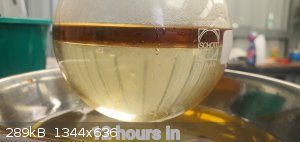 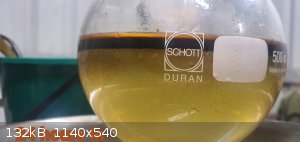 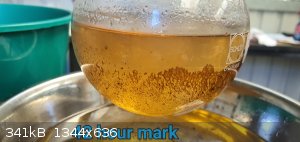 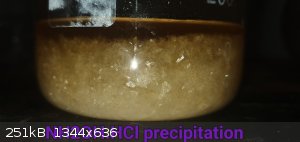 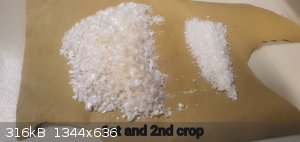
Be good, otherwise be good at it 
|
|
|
sffap
Harmless

Posts: 7
Registered: 12-12-2018
Member Is Offline
|
|
I've also performed this synthesis more times than I care to remember but I found the sweet spot for ~75% yields was to use 25% HCl instead so that
you keep more of the HCl in the liquid phase. A highly efficient reflux condenser is very handy too to keep everything from escaping. Remember MeNO2
boils around 100 C.
However, you don't need to perform the reaction at 100 C either. The last reaction I did was outside in winter and the ambient temp prevented my oil
bath from getting the reaction mixture above 94 C but after 40 hrs constantly refluxing that MeNO2 layer was entirely gone, and the remaining liquid
only had a light straw-yellow colouration.
As others have mentioned, multiple recrystallisations from water (and a few cold methanol washes at the end) work wonders for eliminating the
remaining acid which I believe is formic acid. Boiling the reaction mixture hard to reduce the volume and induce crystallisation will eliminate a fair
bit of acid so watch out for those fumes too!
Stirring is also unnecessary as it doesn't seem to drive the reaction forward in any meaningful way.
|
|
|
Tsjerk
International Hazard
    
Posts: 3032
Registered: 20-4-2005
Location: Netherlands
Member Is Offline
Mood: Mood
|
|
I just ran this reaction and got a 87% yield, I used 1.2x excess azeotropic HCl.
After 24 hours I started distilling off water, formic acid and left over HCl, but there was nitromethane coming over directly. So I returned
everything to the flask and refluxed for another 24 hours.
After that I reduced the volume to 1/3, crystallized the first crop. Reduced the supernatant to 1/3 to get a second crop. That supernatant was reduce
to almost nothing and those solids were dissolved in methanol and crystallized. The first crop was very acidic, and the last grams are yellow.
So I suspended everything in boiling methanol and added a little water to get everything to dissolve. Crystallized a first crop, boiled down to 1/3,
got a second crop and recrystallizated the last almost boiled to dryness bit from methanol.
I only read later hydroxylamine sulfate is insoluble in methanol. If I would do this again I would use sulfuric acid, less excess to prevent
dehydration when distilling the formic acid and use methanol to get the hydroxylamine to crystalize.
[Edited on 6-3-2022 by Tsjerk]
|
|
|